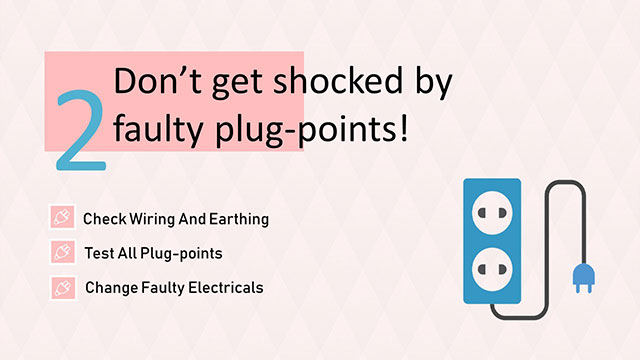21 Things to do when moving to a New Home for First time

Kudos on finding a lovely house! Moving to a new home is a big step and calls for celebrations indeed! However, before turning the key in the door, there are a couple of things you need to take care of (plenty of repairs and checks). We know that you’re already stressed out with all the moving and you wouldn’t want to add more tasks to your list. However, completing these tasks before your boxes reach the place will make settling down that much easier!
Luckily for you, we’ve put together a list of all the things you need to do so that you don’t have to worry about where to start. Check out all the tasks you’ve to do to make your home ready to live in:
- Deep clean your new house
- Don’t get shocked by faulty plug-points!
- Check for leaking taps and pipes
- Ensure the meters are reading correctly
- Get utilities ready to lead a normal life
- Take care of the creepy-crawlies!
- Change the locks for extra safety
- Plan the layout of all your rooms
- Make sure your furniture fits
- Paint new colors for a fresh look
- Replace the old and shabby fittings
- Think about the home decor
- Add curtains for better look and feel
- Make your home self-energy efficient
- Know your new neighbors
1. Deep clean your new house

You can turn over a new leaf and make a fresh start by thoroughly cleaning the property that you’re about to move into from top to bottom (literally!). During deep cleaning, you can pinpoint and tackle many issues in the house that you didn’t notice when you finalised it.
How to do it:
- Start with the ceilings followed by windows, so that dust will sprinkle onto the floor and be cleaned up in the end.
- Next, disinfect the bathroom and scrub every surface thoroughly; also, consider replacing the toilet seats.
- Target the kitchen next and work hard to remove the greasy oil stains; make sure every nook and corner is spotless.
- Next, sweep or vacuum-clean to remove the dirt and grime in all the rooms, focusing mainly on the corners.
- Finally, mop the entire house with a hygienic floor-cleaner to get spick-and-span floors.
- Once you’re done inside the home, clean up the entrance and make it welcoming.
2. Don’t get shocked by faulty plug-points!

Old wiring in the house or improper Earthing/grounding can be hazardous for you and your family. It’s important to check the present state of the electrical wiring in the house and ensure all the sockets are working fine.
How to do it:
- Take an electrical engineer to check the wiring and Earthing of the property.
- Test every plug-point and switchboard in the house.
- Upgrade old outlets to the latest current-voltage requirements.
3. Check for leaking taps and pipes

You need to properly check the plumbing in the house for leaks and fix or replace them immediately. Keep an eye out for dripping taps, faucets, old sink drain pipes, leaking water-heaters, trickling toilets and clogged drains. Locate the water valves and check them for seepage as well.
How to do it:
- Clear out clogged drains;
- Replace dripping taps, faucets and old pipes;
- Repair leaking water valves;
4. Ensure the meters are reading correctly

An easier way to detect faulty electrical connections or plumbing issues is by checking the readings of the electricity and water meters.
How to do it:
- Note down the meter readings when you reach your new home;
- Continue with other work around the house, preferably not using any electricity or water;
- After about two hours, recheck the meter readings;
The initial and final readings should be the same. If not, you need to identify and fix faulty meters, plumbing leaks or defective electrical outlets.
5. Get utilities ready to lead a normal life

It’s a known fact that no one can start their day without access to Facebook, coffee or the daily news. Hence, you need to be prepared with all these services so that you have a normal start to your daily routine after moving.
How to do it:
Call up these essential utility departments and tell them the specific date on which you want the services to begin:
- Electricity board;
- Water supply;
- Gas connection;
- Internet service provider;
- Milk and newspaper vendors;
- TV Cable;
6. Take care of the creepy-crawlies!

The most recent tenants of the property before you decided to buy or rent it, were probably cockroaches, spiders, rats, termites, and other uninvited guests! Scour through the entire house for these creepy-crawly insects and make sure you get rid of them entirely.
How to do it:
- Carry plenty of bug repellents with you when you visit the home for a check and spray inside the entire house;
- If you can’t handle such a task, get a pest control team to do the job properly and thoroughly;
- Check for tiny cracks and openings around your windows, doors and floor corners, and seal them up immediately;
- Clean the kitchen thoroughly and make sure there’s no food easily accessible to these hungry pests;
- Bugs prefer to hang out in damp places, so dehumidify any moist areas of the house and make sure it’s always dry;
- Make sure you clear out the garbage outside or around your home;
Bugs are always looking for ways to get into your home all the time, so it’s helpful to follow these steps in the future as well. Keep bug repellents in the house at all times and make sure you aren’t giving any reasons to these disease-spreading creatures to visit you.
7. Change the locks for extra safety

You can never know for sure how many people have the key to your new home, so it’s safer to change the locks before moving in. However, being able to do so depends on which kind of property you’re moving into, such as:
- If you’ve recently bought the house, you’re the owner so, you can easily replace the locks.
- If you’re moving into a rented property, most owners do not allow for the locks to be replaced. So, you could get assurance from them that the only copies of the house keys are with you both.
8. Make sure your furniture fits

Your furniture may fit perfectly in your current home and also go well with those interiors. However, you need to check how suitable it will be in the new house and also make sure it will be able to fit through the doors.
How to do it:
- Take measurements of all the doorways and rooms with a tape measure;
- Keep your furniture dimensions handy;
- Cross-check to see if your furniture can be appropriately accommodated;
If you feel the furniture will not fit in or match the interiors of your new home, you can consider replacing them. This could be a great opportunity for you to up your home’s style quotient with modern furniture.
- You can quickly sell or exchange your old furniture and buy new ones from these websites – Pepperfry, Quikr, and OLX.
- Post free ads with photos of your furniture and browse through other options on what to buy next.
9. Plan the layout of all your rooms

While you’re at your new home getting it ready before moving in, you can also plan how to arrange your things. Deciding where and how you want to set the furniture and other decorations will save you much time after moving in because you already know where everything must go.
How to do it:
- Take proper measurements of the rooms and furniture so that you can plan where to place everything.
- Natural daylight makes a room come alive and look spacious, and plants add a feeling of freshness.
- Consider your and your family’s lifestyle when sketching out a layout for all the rooms.
10. Paint new colors for a fresh look

The walls of the new house may seem dull and boring or possibly have the artwork of the former tenants’ kids. You could consider changing the wall colours before moving in since painting an empty home is much easier than after it’s filled with things.
How to do it:
- You could choose colours depending on the furniture and decor you already have.
- Alternatively, certain websites let you upload a picture of your home and visualise your room painted with a particular colour.
- Some of the popular websites that allow you to do this are Dulux Colour Visualizer, Berger Paints Virtual Colour Painter and Glidden Visualise Colour.
11. Replace the old and shabby fittings

It’s easy to overlook small details that make your new house look old, like dirty switch plates, old dusty fans, blackened tube lights and bulbs, etc. Consider replacing these old fixtures so that your walls and ceilings have a fresher look.
How to do it:
- Use modern switch plates that are safe and easy to use;
- Install fans that are more in-line with your style;
- Replace old bulbs with power-saving LED ones;
12. Think about the home decor

You can transform your home by decorating it in the right way. The whole process of interior designing can be a family project where you’ll get together and make your home a comfy and exciting place to live.
How to do it:
- Decide on a theme for the house and fancify it with different products.
- Think about adding new lighting, furniture, wall paintings, photo frames, carpets, cushions and other things that make your home unique and to your liking.
- If you’re not sure how to decorate, but you really want to do it, take inspiration from these helpful websites - Hometown, Pinterest, and Homify.
13. Add curtains for better look and feel

Curtains and drapes for your windows increase not only the sense of privacy but also the level of sophistication and comfort. Think about the type and colour schemes of curtains you want to install, based on how to decide to decorate your home.
How to do it:
- Plan whether you want curtains or blinds, the texture, length, width, colours, pattern, and everything else.
- The best way to choose curtains is to visit the closest curtain store near you.
14. Make your home self-energy efficient

You can consider installing solar panels for lighting up your home and heating water. By using solar power, you can cut down on electricity bills and save plenty of money.
How to do it:
- Conduct a home energy audit to understand the total electricity usage of your home and how to improve energy efficiency.
- You can directly take a solar power solution from leading companies like, Luminous, and Tata Power Solar Systems among others, or compare different options in Loom Solar.
- Switch to CFL and LED light bulbs and find other ways to reduce energy consumption.
15. Know your neighbors

One of the main things that can make you feel more relaxed and comfortable while moving in is getting to know the neighbours. Having a good relationship with the neighbours will help you have peace of mind and feel safe in many situations.
You can spend a few minutes of your time to introduce yourself to the neighbours while you’re at the house doing pre-move cleaning, handling various repairs or giving the home a new look. You can let them know that you’ll be moving in real soon. Also, it’s a great way to make your kids and pets feel more comfortable around the new neighbourhood.
Moving into a house that’s not fully ready is not only difficult to manage but also dangerous for living. Old wiring and worn out sockets can give you electric shocks, leaky plumbing can give you sleepless nights, and a dirty kitchen will put your family’s health in jeopardy. All the time, effort and money you spent before moving there will not be worth it in the end. You’ll never be able to enjoy living in such a house, and you’ll have to put in more time eventually to get these issues fixed.
To avoid all of these situations and have a joyful time in your new home from day one, it’s vital that you make it ready to live in. Preparing the new home involves extensive cleaning, repairs, re-painting, and interior designing and decoration. Moreover, it’s much more convenient to do all these tasks before the furniture and boxes arrive; so, spend a day or two before moving day to get everything in working order.
On a final note, we hope you’ve obtained enough information and ideas to get started on your new home preparations! We’re continually looking for more original and unique things people can do in their new home. So, come back soon to find new tips added to this list.
Let the renovations begin!











